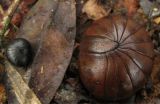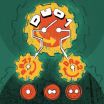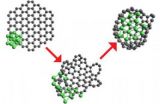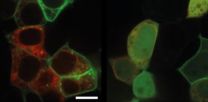(Press-News.org) VIDEO:
A new Western University study led by Dr. Evelyn Vingilis has found a significant decline in speeding-related fatalities and injuries among young men in Ontario since the province's tough extreme...
Click here for more information.
A new study out of Western University (London, Canada) has found a significant decline in speeding-related fatalities and injuries among young men in Ontario since the province's tough extreme speeding and aggressive driving laws were introduced in 2007. The study found a sustained reduction of about 58 speeding-related injuries and fatalities a month among males aged 16-24. That means about 700 fewer young men have been injured or killed in speeding-related crashes yearly since the law was passed.
The study led by Evelyn Vingilis, PhD, a professor in Family Medicine, and Epidemiology and Biostatistics at Western's Schulich School of Medicine & Dentistry, evaluated the deterrent impact of Ontario's Street Racers, Stunt, and Aggressive Drivers Legislation (Bill 203) and found it is making a difference, not only in the number of convictions but also in reducing the number of collisions.
Under the law,* drivers caught going 50 kph over the speed limit or engaging in improper actions that constitute a driving stunt, contest, or race can immediately have their licences suspended and their vehicles impounded for seven days. Upon conviction, they also face a fine of $2,000-$10,000, licence suspension for up to two years or six demerit points, and the possibility of up to six months in jail. The penalties get even more severe with a second conviction.
"First of all we looked at males and females, and then we looked at younger and older individuals because we know from my earlier research, that street racing and extreme speeding is an activity that typically younger males are more likely to engage in," said Vingilis. "What we found was a substantial reduction in the number of convictions for extreme speeding for males, and no change for females because they were pretty low any way. And importantly, we found a significant decrease in the number of motor vehicle casualties of males 16 to 24 -quite a significant reduction."
Vingilis says the study's findings support deterrence theory to the effect that certain, swift and severe sanctions can deter risky driving behaviour.
The research, conducted in collaboration with the Ministry of Transportation of Ontario (MTO), looked at data from January 1, 2002 to December 31, 2011. The law came into effect September 30, 2007, enabling the researchers to compare the data before and after implementation. From the time the new law came into force to the end of 2011, more than 24,000 drivers' licences were suspended for violating the new street racing legislation, nearly 8,500 of them in the first year alone.
For the 16 to 24 year old male drivers, 1.21% of licensed drivers had their licences suspended, along with .37 per cent of mature males (aged 25-64). That contrasted with .21 per cent for 16-24 year old female drivers and .07 per cent for 25-64 year old women.
INFORMATION:
The research team which included Aizhan Meirambayeva, Guangyong Zou, Yoassry Elzohairy, Ian McLeod, Jinkun Xiao, Yuanhao Lai and Vingilis, has had findings published online in advance by two journals. The study on casualties is in Accident Analysis & Prevention and the study on convictions is in Traffic Injury Prevention.
The research was funded with a grant from AUTO21, a member of the Networks of Centres of Excellence program, which is administered and funded by the Natural Sciences and Engineering Research Council (NSERC), the Canadian Institutes of Health Research (CIHR) and the Social Sciences and Humanities Research Council (SSHRC), in partnership with Industry Canada.
* Specifically, section 172 of the Highway Traffic Act prohibits driving a motor vehicle in a race or contest, while performing a stunt, or on a bet or wager. The supporting regulation (Ontario Regulation 455/07) to section 172 includes the definitions of key terms used in the legislation--"race", "contest" and "stunt."
Tougher penalties credited for fewer casualties among young male drivers
2014-06-06
ELSE PRESS RELEASES FROM THIS DATE:
Endoscope with an oxygen sensor detects pancreatic cancer
2014-06-06
JACKSONVILLE, Fla. — June 6, 3014 — An optical blood oxygen sensor attached to an endoscope is able to identify pancreatic cancer in patients via a simple lendoscopic procedure, according to researchers at Mayo Clinic in Florida.
The study, published in GIE: Gastrointestinal Endoscopy, shows that the device, which acts like the well-known clothespin-type finger clip used to measure blood oxygen in patients, has a sensitivity of 92 percent and a specificity of 86 percent.
MULTIMEDIA ALERT: Video and audio are available for download on the Mayo Clinic News Network.
That ...
Magnetic moment of the proton measured with unprecedented precision
2014-06-06
One of the biggest riddles in physics is the apparent imbalance between matter and antimatter in our universe. To date, there is no explanation as to why matter and antimatter failed to completely annihilate one another immediately after the big bang and how the surplus matter was created that went on to form the universe as we know it. Experiments conducted at Johannes Gutenberg University Mainz (JGU) have contributed towards a resolution of this problem. For the first time a direct and high-precision measurement of the magnetic moment of the proton has been conducted ...
A new way to make laser-like beams using 250x less power
2014-06-06
ANN ARBOR – With precarious particles called polaritons that straddle the worlds of light and matter, University of Michigan researchers have demonstrated a new, practical and potentially more efficient way to make a coherent laser-like beam.
They have made what's believed to be the first polariton laser that is fueled by electrical current as opposed to light, and also works at room temperature, rather than way below zero.
Those attributes make the device the most real-world ready of the handful of polariton lasers ever developed. It represents a milestone like none ...
New species of ancient chirping giant pill-millipedes from Madagascar already threatened
2014-06-06
An international team of researchers comprised of Thomas Wesener, Museum Koenig, Bonn, Daniel Le, Field Museum, Chicago and Stephanie Loria, American Museum of Natural History, New York, discovered seven new species of chirping giant pill-millipedes on Madagascar. The study was published in the open access journal ZooKeys.
The species discovered all belong to the genus Sphaeromimus, which is Latin for 'small ball animal'. However, the designation 'small' is not always true for the members of the genus as one of the newly discovered species surprises with a size larger ...
Probiotics prevent deadly complications of liver disease
2014-06-06
Bethesda, MD (June 6, 2014) — Probiotics are effective in preventing hepatic encephalopathy in patients with cirrhosis of the liver, according to a new study in Clinical Gastroenterology and Hepatology, the official clinical practice journal of the American Gastroenterological Association. Hepatic encephalopathy is a deterioration of brain function that is a serious complication of liver disease.
"This rigorous new research finds that probiotics modify the gut microbiota to prevent hepatic encephalopathy in patients with cirrhosis of the liver," said David W. Victor III, ...
Shatterproof screens that save smartphones
2014-06-06
University of Akron polymer scientists have developed a transparent electrode that could change the face of smartphones, literally, by making their displays shatterproof.
In a recently published scientific paper, researchers demonstrated how a transparent layer of electrodes on a polymer surface could be extraordinarily tough and flexible, withstanding repeated scotch tape peeling and bending tests. This could revolutionize and replace conventional touchscreens, according to Yu Zhu, UA assistant professor of polymer science. Currently used coatings made of indium tin ...
Breakthrough study solves plant sex mystery
2014-06-06
A team of biologists from the University of Leicester has solved a mystery surrounding how plants have sex.
The researchers have discovered a pair of proteins made by flowering plants that are vital for the production of the sperm present within each pollen grain.
Scientists already knew that flowering plants, in contrast to animals, require not one, but two sperm cells for successful fertilisation: one to join with the egg cell to produce the embryo and one to join with a second cell to produce the nutrient-rich endosperm inside the seed.
The mystery of this 'double ...
Method of nickel-carbon heterofullerenes synthesis presented
2014-06-06
Scientists from several British, Spanish and Russian research centers (MIPT, Institute for Spectroscopy RAS, Kurchatov Institute and Kintech Lab Ltd) have come up with a method of synthesizing a new type of nickel-carbon compound. The article titled Formation of nickel-carbon heterofullerenes under electron irradiation has been published by Dalton Transactions and is available as a pre-print at arxiv.org. The first author of the article is Alexander Sinitsa, an MIPT student, and the leading author is Andrey Popov (Institute for Spectroscopy RAS, 1989 MIPT graduate).
Heterofullerenes ...
Mitochondrial DNA of first Near Eastern farmers is sequenced for the first time
2014-06-06
The mitochondrial DNA of the first Near Eastern farmers has been sequenced for the first time. In the research, published in the journal PLOS Genetics, experts analysed samples from three sites located in the birthplace of Neolithic agricultural practices: the Middle Euphrates basin and the oasis of Damascus, located in today's Syria and date at about 8,000 BC.
The paper is signed by Daniel Turbón and Alejandro Pérez Pérez, from the Department of Animal Biology of the University of Barcelona (UB); Eva Fernández, from Liverpool John Moores University; Cristina Gamba, Eduardo ...
Herpesviruses undercover
2014-06-06
This news release is available in German.
The Kaposi's sarcoma-associated herpesvirus (KSHV), a gammaherpesvirus that can cause multiple forms of cancer, establishes lifelong infections within the body. To do so the virus has to find a way to modulate the immune system of its host.
„Intruders are usually fought off immediately by an antiviral immune response that is triggered by sensors including the toll-like receptors (TLR)," says HZI researcher Dr. Kendra Bussey, author of the study that was published in the "Journal of Virology". Toll-like receptors detect ...








